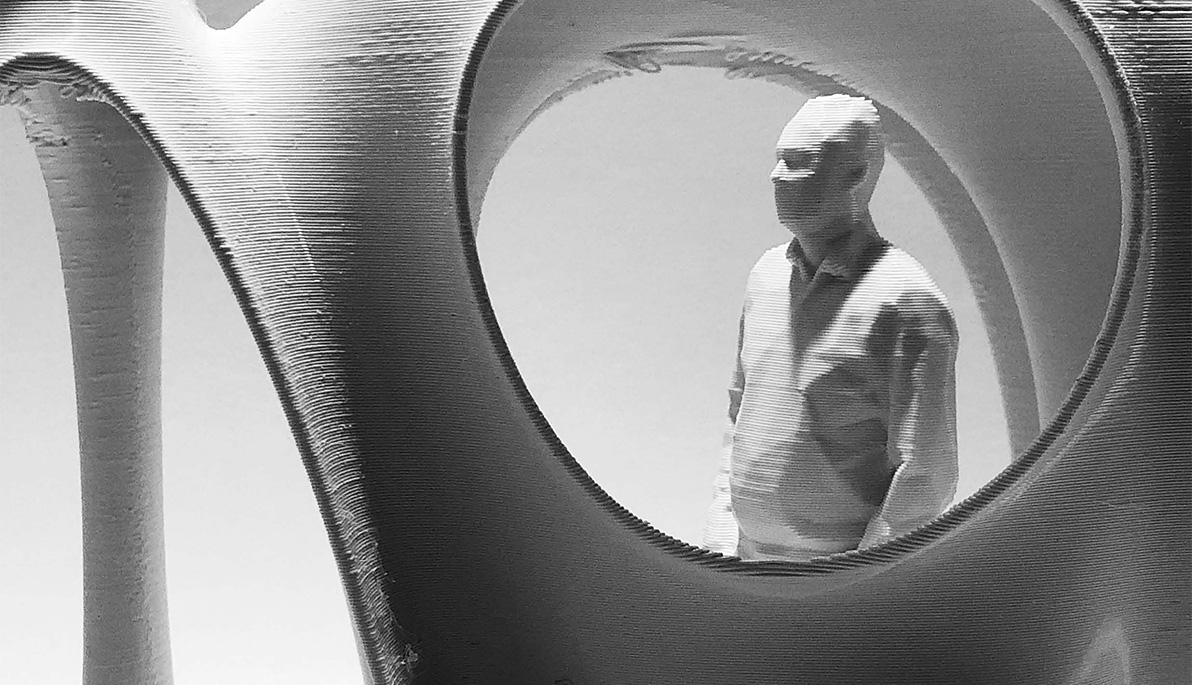News
School of Architecture and Design Launches Two Master’s Degree Programs
September 28, 2020
Pictured: Robotic Fabrication created by New York Tech student Ben Stather was part of a student research studio pilot project for the new master’s in architecture, computational technologies program. It is an installation proposal for the Venice Biennale to be held May 22, 2021, at Palazzo Bembo in Venice, Italy.
NYIT School of Architecture and Design has added two new master’s degree programs in the fall 2020 semester: architecture, computational technologies; and architecture, health and design. The programs will prepare graduate students for architecture careers of the future by introducing them to the advanced technologies used in design and building today as well as focusing on the latest approaches to well-being for a better quality of life and to healthcare spaces.
These new architecture programs join New York Tech’s more than 90 degree offerings and in-demand disciplines ranging from computer, cyber and data science, and engineering, to biology, biotech, pre-med, nursing, business, UX/UI, digital design, urban design, and health and medical sciences, among others.
The School of Architecture and Design celebrated the launch of the degrees at the M.S. Launch: Designing Architectural Research – Virtual Exhibition Opening and Panel Discussion on September 16. The event featured works from 24 leaders in the discipline and industry, a group of thinkers and makers who are reconsidering conventions at the forefront of architectural and design practices, including Behnaz Farahi; Futureforms; Niccolo Casas & Anouk Wipprecht, Matsys & Lake|Flato, Studio Bitonti, Institute for Computational Design and Construction, Stuttgart University; IJP Architects; Phillip Rahm Architectes; and Zaha Hadid Architects, among others.
“Supported by a $2 million grant from the IDC Foundation, the Master of Science in Architecture, Computational Technologies, and the Master of Science in Architecture, Health and Design have the ambition to immerse students in a transformative learning environment that advances new knowledge while blurring disciplinary boundaries and working across fields and expertise,” said Maria Perbellini, M.Arch., dean of the School of Architecture and Design. “Focusing on experimental applied research, students will creatively innovate in our expanded state-of-the-art fabrication lab facilities, with the unique opportunity to intersect the two programs through emergent technologies. From 3-D printing models and artificial intelligence within the design process to augmented reality, simulation and robotic systems to aid construction and amplify the spatial experience to a stronger interaction with data and information for computational analysis, we will offer speculative yet evolving design approaches and architectural production. It is important to interconnect the two programs as they are conceived to infusing each other.”
Architecture, Computational Technologies, M.S.ACT
While architects are accustomed to using digitized design tools and methods, the architect of the future will program software and use robotics and machine learning to design and build their projects.
The Master of Science in Architecture, Computational Technologies is a one-year, 30-credit post-professional degree that integrates critical relationships between science and culture, developing new technologies with a focus on the history and theory of representation, robotics, and cybernetics. Students will learn how to design and build models, prototypes and building components using the latest technologies in computational design, robotics and fabrication, and new materials.
“Students will discover possible futures for the discipline of architecture by expanding design authorship through innovations in algorithms and interfaces, robotic systems, and new materials,” said Pablo Lorenzo-Eiroa, M.Arch. II, director of the program. “Ultimately, an architecture of information will be activated through transformative spatial conceptions, built ecological architectural prototypes, and interactivity at full virtual and actual scales.”
Graduates can pursue careers in architecture with a focus on:
- Computational Design
- Simulation, Big Data, Machine Learning, AI
- Programming, Applications, Interfaces, Software Design
- Environmental Design
- VR, MR, AR
- Robotics and Fabrication
- Robotics Systems Design
- Materials Design
- Composite Materials, Responsive Materials, BioMaterials, Live Materials
Learn more about architecture, computational technologies.
Architecture, Health and Design, M.S.AHD
It used to be that when one heard “hospital” they would envision an uncomfortable, stark white space with bright lights. However, healthcare spaces of the 21st century are moving towards comforting environments designed with the patient and healthcare providers in mind. But with that comes a new, more holistic approach to health and wellness.
“There is the urgency to reframing the inherent and meaningful spatial relation between human health, well-being, and our built and natural environments with a novel set of skills and a more conscious mindset,” said Perbellini.
Students will learn how to design the spatial futures for treatment and convalescence, rethinking how design and building impact humans beings.
In this one-year, 30-credit post-professional master’s degree program, studios and courses will concentrate on computational design, prototyping, augmented and intelligent materials, and environmental systems. Students will develop skills and expertise in design technologies (simulation, visualization, robotic interactions, and fabrication, etc.) exploring multidisciplinary architectural research and practice at the intersection of design and the medical/healthcare and health sciences fields.
Graduates with this degree can pursue careers in architecture with a focus on:
- Healthcare Design
- Health and Wellness Design
- Institutional Space Planning
- Interior Design
- Environmental Design
- Computation and Fabrication
- Composite Materials, Responsive Materials
- Biomaterials, Live Materials
- Simulation, Big Data, Machine Learning AI
- VR, MR, AR
Learn more about architecture, health and design.
Learn more about NYIT School of Architecture and Design.





